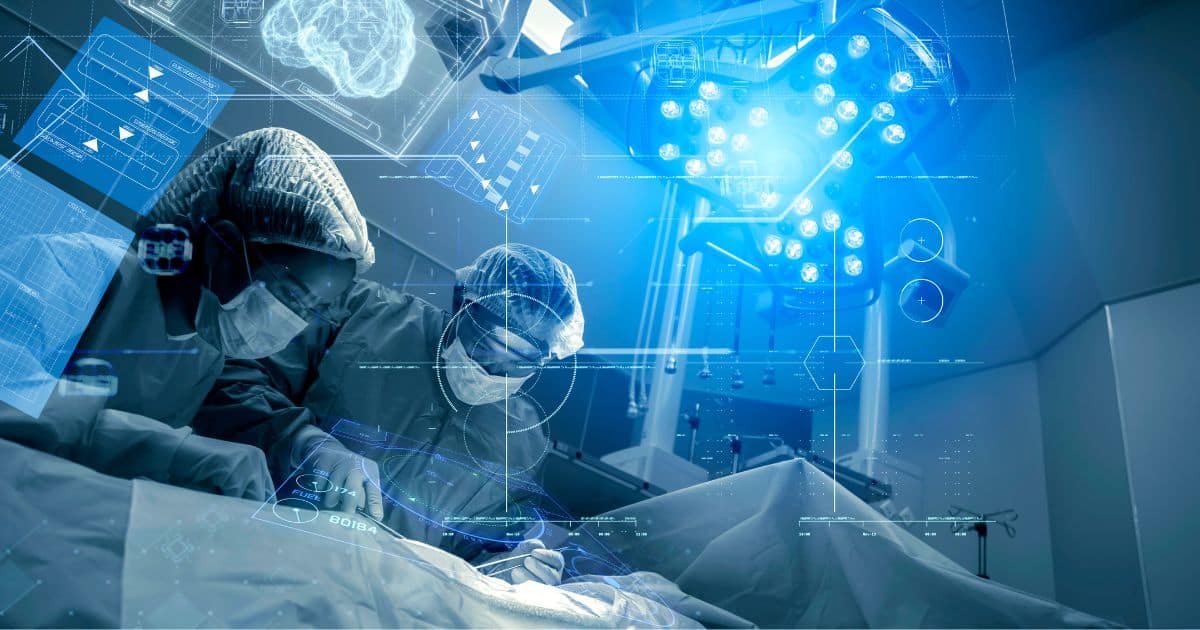
Video
University of Iowa Hospitals and Clinics Embrace Data-Driven Healthcare
Watch Now

Caresyntax Blog
September 9, 2022
This Thieme OP Management up2date article explores the innovative medical technology that can enable the automatic collection and evaluation of data, the integration of support systems for improving clinical workflow, and medical decision-making, as well as artificial intelligence (AI) that can lead to creating a digital safety net for the OR.
Digital OR surgical data is already collected in large quantities today; however, there are not many comprehensive systems that enable actionable data integration. There are no standards regarding format and evaluation, and a clear clinical reference is not always given.
Creating a digital operating room (OR) is much more than an operating room equipped with the latest medical technology. To take full advantage of complex digital systems, there is an urgent need to introduce a digital safety net for ORs, which includes innovative and optimally integrated OR technologies: surgery data platforms, OR analytics and surgical intelligence management software; video-based assessment, and telepresence and remote monitoring for the OR.
This digital surgery safety net can improve the way surgical procedures are performed and analyzed. Innovative OR technologies can be used to collect data to offer valuable insights for surgeons and surgical staff before, during, and after operations to:
In addition, these tools can lead to improved patient experience, while also ensuring greater patient safety.
Digital surgical technology platforms can form a real safety net—from start to finish—for surgical operations. Surgery is in an era of innovation with data, decision support, and workflow as its foundation. Digital surgery platforms are bringing transformational improvements to clinical, operational, and financial outcomes.
The telephone of the experienced surgical senior physician rings. He is needed to take over the elective laparoscopic cholecystectomy of Mrs. B., because his scheduled colleague has to pick up his sick son from kindergarten. The patient is already intubated and ventilated in the operating room.
The surgeon does not know Mrs B. He skims through the digital patient file in the hospital information system, looks at the laboratory results in an external laboratory program, and needs a third program to call up the computer tomography images.
Pronounced adhesions make the operation difficult, the anatomy is not easy to recognize. The surgeon asks the OR tech to look again in the file for previous operations in case he has overlooked something. The surgeon leafs through the file and calls up a file archiving program on the computer, into which older files are scanned as PDFs, as well as handwritten notes. The operating room nurse searches, but cannot find an operation. There is no scar to be seen.
Exactly at the moment when the bile duct is being set down, the OR nurse calls in. She has found a blurry scanned PDF file in the archiving program. The patient was operated on as a child for pyloric stenosis. This is probably the cause of the difficult anatomical conditions. In the meantime, the cholecystectomy has been completed and the patient has been taken to the recovery room.
Devices used in the OR continuously generate data: vital signs, depth of anesthesia, X-ray fluoroscopy time, specific operating room times, etc., but only very few of these data are currently collected, let alone analyzed. Old paper files are scanned and stored in portable document format (PDF), usually in separately archived software. In addition, the majority of the hospital’s correspondence with registered doctors exists mostly in paper form.
Increasing efficiency and quality requires the continuous collection, storage, and evaluation of all available operative and perioperative data.
Most data cannot be passed back and forth between the different systems. Typical data silos are, for example, the separate systems of diagnostic imaging (PACS), laboratory examinations (LIS), and a larger hospital information system (HIS).
Increasing efficiency and quality requires continuous collection, storage, and evaluation of all available operative and perioperative surgical data.
The surgeon finds the bile duct but has difficulty exposing it for clipping. The anesthesiologist asks if he should order the next patient, otherwise, the case might be canceled.
The surgeon clips the bile duct after safely identifying it but has an inadequate view of the ends of the clipping branches.
Groundbreaking surgical data platforms include machine learning and the integration of AI in the automated, continuous analysis of all available data. An adaptation of these methods and the creation of “Surgical Intelligence” is promising, leveraging AI for greater insights into the reduction of complications, delivering higher survival rates, and improving patient quality of life.12 Machine learning has already been shown that machine learning predicts wound healing disorders after surgical interventions more accurately than the widely used logistic regression models.14
Recently, an international study also showed that AI and machine learning could be of great help in laparoscopy. “ClipAssist-Net” was presented here as a real-time feedback mechanism.16 Artificial intelligence can be used to recognize which phase the surgeon is in when performing laparoscopic cholecystectomy. During laparoscopic cholecystectomies, the program can recognize whether the clip was placed under visual control before the bile duct was removed. If the branch ends of the clip forceps were not visible, the program could indicate this to the surgeon.16
By linking continuous evaluation of collected video data and linking data with the intra- and post-operative course, it is possible to use machine learning to develop algorithms that automatically detect potential errors during the actual operation and send warning signals before they even occur.
The digital evolution of video-based assessment (VBA) inevitably leads to the linkage with machine learning and AI. By linking continuous evaluation of collected surgery video data and linking data with the intra- and postoperative course, it is possible to use machine learning to develop algorithms that automatically detect potential errors during the actual operation and send warning signals before they even occur. This provides administrative support through automated documentation of intraoperative data, but also direct automated feedback to relevant decision-makers from OR management and hospital leadership. Relevant process steps are actively tracked by the digital platform, and deviations are detected and highlighted. This leads to data-based decisions for greater efficiency.
When the patient with the inguinal hernia is lying in induction, a greenish fluid is noticed in Mrs B’s drainage. There seems to be a bile leak. The surgeon gives the indication for immediate revision surgery after being alerted to the complication by attentive nursing staff in the recovery room.
When the muscle relaxant is being injected into the next patient, the OR manager receives information about an upcoming emergency operation. He informs the anesthetist, who has just successfully intubated the follow-up patient, that the patient is intubated, ventilated, and under general anesthesia. Due to a lack of OR capacity, parallel care of the elective patient and the emergency case is not possible.
Therefore, the OR manager decides to cancel the elective procedure and let the patient who was scheduled for hernia surgery wake up, while the patient who has now become an emergency after cholecystectomy, Mrs. B., is wheeled into the theatre, where clips that have not been correctly placed can be seen.
Through the continuous flow of data, the system signals to the OR manager that there has been a delay of about 10 minutes during the procedure. Based on the available patient data, this delay had already been predicted and announced by the system.
Using case length data and benchmarking, individual cases, including preoperative preparations and induction, are recorded and tracked “live.” This makes it possible to increase efficiency through benchmarking and proactive OR block utilization management.
The seamless integration of all existing software and hardware solutions into a new, overarching digital OR system in the sense of a digital safety net still remains a challenge. An initial investment is required, which some hospital operators shy away from, especially due to the fact that there is primarily no counter-financing and free capital is rarely available. However, it is too easy to use the lack of financial resources as a counter-argument.
Without a certain change in thinking, both in management and in the clinical sector, the introduction of such systems will be delayed. A network of digital applications integrated into a single OR technology platform, that includes continuous big data analysis and AI as well as machine learning, represents a digital safety net for the OR. There is an urgent need to apply AI and machine learning in surgery, combined with systematic data collection that is more efficient and that does not require additional staff time. AI can be used to alert the surgeon of critical surgical steps or anatomical conditions in advance to inform the best decision-making for each case. Video-based assessment can serve as a tool for avoiding complications and improving surgical skills.
Advanced digital platforms for surgical data collection and evaluation are currently available and have the ability to minimize surgical complications and drive surgical process optimization.
This blog is an excerpt from, “The Digital Operating Theatre: Maximum safety and efficiency through networking, big data, and artificial intelligence,” published in Thieme OP Management up2date, a German medical and scientific publication.Thieme is an award-winning international medical and science publisher serving health professionals and students for more than 125 years.
If you are interested in receiving the original article published in German, CLICK HERE.
References
The Digital Operating Theatre: Maximum safety and efficiency through networking, big data, and artificial intelligence. OP-Management up2date. Thieme. DOI 10.1055/a-1714-0411. 2022.
[12] Hashimoto DA, Rosman G, Rus D et al. Artificial intelligence in surgery: promises and perils. Ann Surg 2018; 268: 70–76 doi:10.1097/SLA.0000000000002693
[14] Snyder RA, Tarpley MJ, Tarpley JL et al. Teaching in the operating room: results of a national survey. J Surg Educ 2012;69: 643–649 doi:10.1016/j.jsurg.2012.06.007
[15] Lopez C, Boddapati V, Lombardi J et al. Artificial learning and machine learning applications in spine surgery: a systematic review. Global Spine J 2022; 21925682211049164:doi:10.1177/21925682211049164
[16] Aspart F, Bolmgren JL, Lavanchy JL et al. ClipAssistNet: bringing real-time safety feedback to operating rooms. Int J Comput Assist Radiol Surg 2022; 17: 5–13 doi:10.1007/s11548-021-02441-x